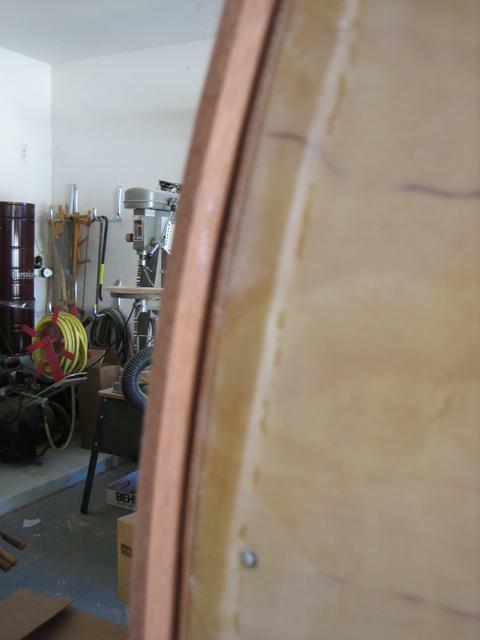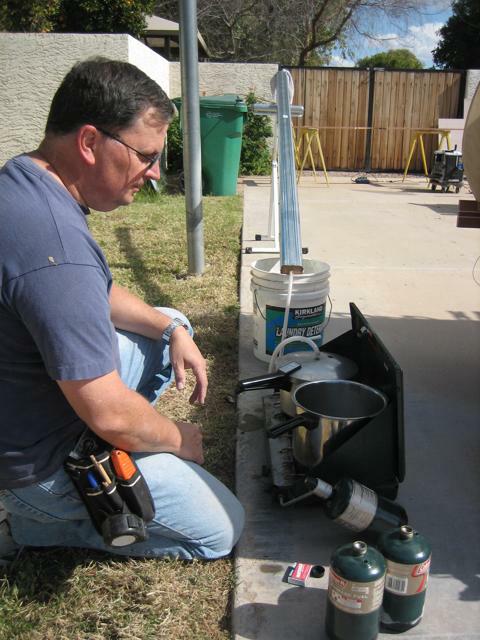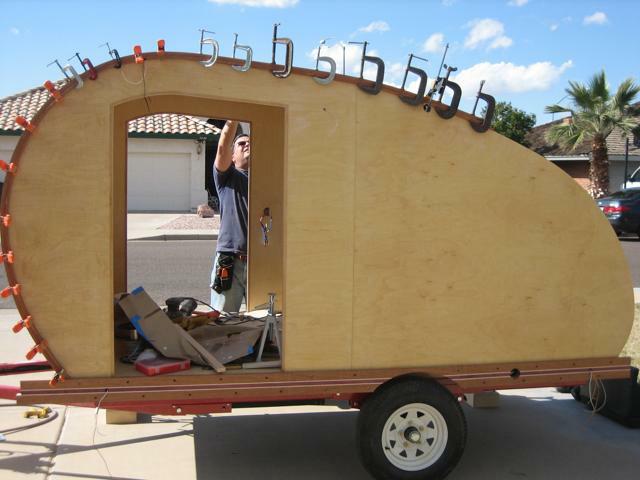I ended up doing steam bent laminations. Use the trailer for the form. Attach a thin, wide strip to the top with screws, overhanging the edge by the thickness of the side wall trim. Don't glue it to the trailer yet.

Next, build a steamer. Mine is a piece of rain gutter downspout, a pressure cooker, and the camp stove. A hotter stove would produce more steam, which would be good. Wires run side to side in the steambox hold the strip off the bottom of the steambox.

While the water boils, rip some thin strips that you will laminate together to form the sides. Mine are 1/2 x 5/16. You want them thin enough you can bend without breaking and wide enough they don't twist when you bend them. When the steam is up put one in the steamer and plug the open end with a rag. Don't put them all in; you can oversteam as easily as understeam.
Allow it to steam 15 minutes for each 1/4 inch of thickness. One thing -- this works best with green wood; a scarce thing where I live. I used dry wood and had a little breakage.
Take out the hot strip and clamp it to the underside of the strip you screwed to the tear. Don't try to glue it. You only have about a minute to work with and that won't allow for messing with glue. Get it clamped up and stick another strip in the steamer. When that strip is hot, clamp it to the strip on the other side of the tear. Working on both sides this way saves some time. Put another strip in the steamer. Now go to the original side, remove the clamps, take off your bent strip, apply lots of glue and clamp it back on. Drive in a few brads to keep it from sliding around. Rest for 10 minutes. Take the next strip out of the steamer and dry clamp it to the one you just glued up. You fall into a rhythm after awhile and at the end of the day you're done.

Keep going until you have built up the thickness you want or you run out of clamps (or patience).
Let the whole mess rest a few days, then remove the screws holding the outer strip to the tear roof. Take off the molding and plane or sand it to final thickness. Then route any edge profile you want before you put it back on the tear. Slather on a mess of epoxy to the inside of the trim where it mates with the tear, and screw it back on. Cover up all the screws with one last wide strip glued on the top strip. The wide strips are wide enough and thin enough that you can probably get by without steaming.
The trim took a full day, including building the steamer. Maybe a bit longer than the pieced together approach, but I like it. You can do this without steam if you like. Just rip thinner strips out of extremely straight grained wood. Not having straight grained wood and not wanting to deal with 1/16 inch strips, I steamed.
BTW - the lower side trim in the last pic is mahogany, maple, and purpleheart. May not be as classy as sdtrippers, but I like it.

